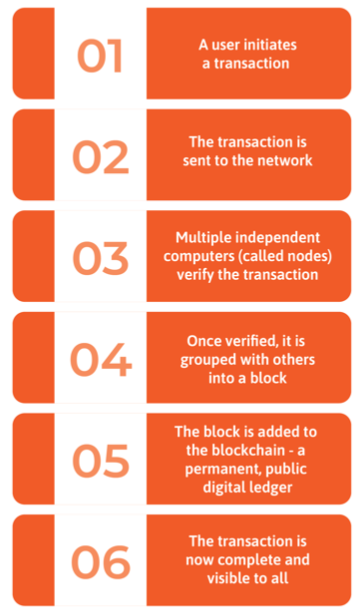Let’s say you want to send ₹500 to a friend who’s studying in Canada. You open your banking app and make the transfer, then wait. It might take a couple of days. There is some fees involved. Meanwhile, your money goes through several checks, with different banks and maybe different countries, all to process one simple transaction.
But, what if we have a system where that same transfer happens almost instantly and at a much lower cost, without needing a bank, a payment app, or any middleman. That’s the kind of change cryptocurrency is aiming for.
But what exactly is it? And why is it such a big deal?
This article explains everything in very simple terms. You’ll get a clear description of what cryptocurrency is, how it works, and why people trust it even without a physical coin or central authority
Let’s start from the beginning.
What Is Money?
Before we understand cryptocurrency, we need to know how regular money works, what we call “fiat currency” or say government-issued currency (like the Indian Rupee, US Dollar, etc.).
At its core, money is just a tool for exchanging value. It works only because we trust it. When you hand someone ₹100, you believe the note is valid, accepted, and backed by the Indian government.
In earlier times, money was backed by gold. Today, it is backed by governments and managed by central banks. When you use your bank’s app to transfer money, your bank checks your balance, confirms the transaction, and updates its records.
But this entire system relies on middlemen: banks, payment apps, and card companies; every step adds cost, delay, and restrictions. This is where Cryptocurrency comes in. It is digital money that is not issued or controlled by any government or bank.
Instead of relying on banks to record and verify transactions, cryptocurrency uses a technology called blockchain to do the same job, but in a decentralized and public manner.
To understand cryptocurrency, we must first understand blockchain.
What Is Blockchain?
To understand blockchain think of it as a notebook that is completely public. Anyone can read it, and every few minutes, a new page is added listing all recent transactions. This notebook is not stored in just one place; it is copied and shared across thousands of computers worldwide.
Once a page is written in this notebook, it cannot be edited or deleted. Every computer has the same copy, so no one can tamper with it. No single person or organization controls it.
This digital, secure, and distributed notebook is called the blockchain. It keeps a permanent record of every transaction in the cryptocurrency world.
What Is a Cryptocurrency?
A cryptocurrency is a type of digital asset recorded on a blockchain. You can send it, receive it, and store it, just like regular money.
The first and most well-known cryptocurrency is Bitcoin. It was introduced in 2009 by a person or group using the name Satoshi Nakamoto. The idea was simple but revolutionary: to create a form of money that didn’t need banks, governments, or central authorities, just a network of computers and code. Satoshi’s whitepaper explained how people could send money directly to one another in a secure and verifiable way using blockchain technology. While many initially dismissed the concept as unrealistic or niche, a small group of developers and early users kept the idea alive. Over time, Bitcoin survived multiple crashes, regulatory challenges, and skepticism, yet it continued to grow. Today, it’s recognized not only as the first successful cryptocurrency but also as “digital gold” because of its limited supply and long-term value perception.
When someone sends you Bitcoin, the network verifies the transaction and records it on the blockchain. The record is updated across all copies of the ledger around the world. There’s no need for a bank to approve it. The system handles everything on its own.

Why Is It Called a "Currency"?
The word "currency" might seem misleading at first. You cannot touch cryptocurrency, and you cannot spend it at most local shops. No government prints it.
But technically, a currency is anything that serves three functions:
- It acts as a medium of exchange
- It stores value over time
- It can be used as a unit to measure value
Cryptocurrencies like Bitcoin and Ethereum meet all three criteria, especially in the digital world. You can exchange them for goods or services, store them over time, and measure value in their units.
Just as a ₹500 note is nothing more than a piece of paper until we agree that it has value, cryptocurrency works because people voluntarily assign value to it. In online and global ecosystems, it already functions as a currency, even though it is not traditional or physical.
Real-Life Example: Blockchain Moving Beyond Just Currency
To understand how far-reaching the idea of cryptocurrency and blockchain has become, consider this: earlier this month, a surprising proposal emerged at the crossroads of geopolitics and tech-driven capitalism. A group of Israeli businessmen reportedly suggested to Donald Trump that they divide land in war-torn Gaza into digital pieces, tokenize them using blockchain, and sell those pieces to global investors.
As strange or even exploitative as it might seem, the proposal highlights something important about our times. We are starting to view the world less in terms of physical ownership and more through digital representations or tokens.
Blockchain technology allows real-world assets like land, art, or shares to be broken into tokens and traded securely around the globe. This shift from traditional to tokenized ownership is no longer just a theory; it is happening. This Gaza land proposal, despite the ethical and political concerns it raises, shows how influential and real blockchain’s role in future economies could be.
Why Would Anyone Trust Cryptocurrency?
Trust is the foundation of any financial system. We trust banks because they are regulated, insured, and backed by governments.
So why do people trust cryptocurrency, which is managed by code and computers?
There are several reasons:
- The code is open and clear: Most cryptocurrencies run on open-source software, so anyone can examine the rules. There are no secrets or hidden processes.
- The blockchain is tamper-proof: Every transaction is recorded publicly. Once recorded, it cannot be changed or deleted. It becomes a permanent, visible part of history.
- Decentralization adds security: No single person, company, or government controls the blockchain. Even if some computers fail or are hacked, the others continue working, making the system resilient.
- Proven track record: Bitcoin, for example, has been operating since 2009 and has never been hacked. This long-term reliability builds confidence.
- Trust through math, not middlemen: Instead of trusting people or institutions, the system relies on code, logic, and agreement across thousands of machines. This creates a new kind of trust based on verification, not reputation.
Where Do You Store Cryptocurrency?
You store cryptocurrency in a digital wallet. This is not a physical wallet; it's an app or software that lets you send, receive, and manage your digital assets.
Each crypto wallet has:
- A public key (like your account number—you can share this)
- A private key (like your password—you must keep this a secret)
If you lose your private key, you lose access to your crypto. There is no customer service or password reset option.
Why Do People Use Cryptocurrency?
There are several reasons why people use or invest in cryptocurrency:
- Freedom from traditional banks and government restrictions
- Fast, low-cost international money transfers
- Privacy and control over their funds
- An alternative investment, especially in countries with weak currencies
- Financial inclusion for people without access to regular banking services
Some also see it as a form of digital gold—a scarce resource that can hold value over time.
What Are the Risks?
Cryptocurrency has many benefits, but it also comes with real risks:
- Prices are highly volatile. Value can change drastically in a short time.
- Regulations are unclear or evolving in many countries.
- There are many scams and fake coins in the market.
- If you lose your private key, your money is gone forever.
Like any new technology, it offers both promise and danger. Understanding how it works is the first step to using it wisely.
Is Cryptocurrency the Future of Money?
It might be, or it might evolve into something more regulated or integrated with traditional systems. But one thing is clear—cryptocurrency has changed how we think about money, trust, and technology. It has opened up the possibility of a financial world without middlemen. Even if you do not plan to invest in cryptocurrency today, understanding how it works is like understanding the internet in the late 1900s. It may not be a daily tool yet, but it is shaping the future in powerful ways.
Source: The Economic Times
Disclaimer:
This article is intended solely for informational purposes and should not be considered as investment advice, endorsement, or promotion of cryptocurrency. Cryptocurrency investments are subject to high risk and volatility. Please consult a qualified financial advisor before making any financial decisions.

